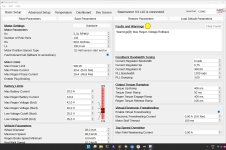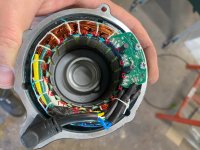Hello!
I am wondering if anyone knows if I can quiet the motor noise on my e-Bike. I have an e-Bike with Shengyi CMT03, it had an inbuilt controller but it was not possible to program the controller and not the best design. I swapped to a Baserunner and CA3 and everything has been working great for around 6 months. You can see more details in my post history.
Since the swap to the Baserunner the motor is much more noisy. To the point where the neighbors comment on it. It was never whisper quiet, but it was much quieter on the stock controller. Is there a parameter I can tweak to get the motor to be more quiet?
Here is a video of the Phaserunner Suite Autotune running and the motor noise. It seems electronic to me and not mechanical.
Here is a video of the motor just being turned by hand. Everything feels fine by the way, there is no resistance other than the gears.
I attached the settings I have used on the baserunner. The motor settings where found via the Autotune (I know the battery limits a set weirdly).
I am wondering if anyone knows if I can quiet the motor noise on my e-Bike. I have an e-Bike with Shengyi CMT03, it had an inbuilt controller but it was not possible to program the controller and not the best design. I swapped to a Baserunner and CA3 and everything has been working great for around 6 months. You can see more details in my post history.
Since the swap to the Baserunner the motor is much more noisy. To the point where the neighbors comment on it. It was never whisper quiet, but it was much quieter on the stock controller. Is there a parameter I can tweak to get the motor to be more quiet?
Here is a video of the Phaserunner Suite Autotune running and the motor noise. It seems electronic to me and not mechanical.
Here is a video of the motor just being turned by hand. Everything feels fine by the way, there is no resistance other than the gears.
I attached the settings I have used on the baserunner. The motor settings where found via the Autotune (I know the battery limits a set weirdly).
Attachments
Last edited:



